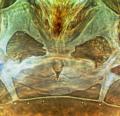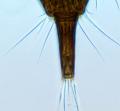Liothrips vaneeckei
Recognition data
Distinguishing features
Both sexes fully winged. Body and legs brown, tarsi and fore tibiae yellow also apical third to one half of mid and hind tibiae; antennal segment II brown, III and IV largely yellow, V and VI variably yellow in basal half; major setae dark brown, tergite IX setae paler; fore wing shaded at base then with a longitudinal dark line medially and also shaded around margins. Head longer than wide; maxillary stylets retracted to eyes, close together medially; post ocular setae pointed, almost as long as eyes; mouth cone extending between fore coxae. Antennae 8-segmented; segment III with one slender sensorium, IV with three sensoria; VIII short, slightly narrowed at base. Pronotum with five pairs of long, softly pointed major setae, posteroangulars almost as long as pronotum medially; epimeral sutures complete; prosternal basantra not developed, ferna present, mesopresternum lateral triangles sometimes weakly joined medially. Fore tarsus without a tooth. Metanotum with narrow elongate reticulations medially, median setae small and acute. Fore wing parallel sided, with about nine duplicated cilia; three long softly pointed sub-basal setae sub-equal in length. Tergite IX setae S1 and S2 finely acute, slightly shorter than tube.
Male similar to female; tergite IX setae S2 short and stout; sternite VIII with an extensive pore plate.
Related and similar species
L. vaneeckei is distinguished from the other members of this genus in California by the more extensive yellow color of the mid and hind tibiae, as well as the extensively yellow antennal segments. Currently, there are 290 species listed in the genus Liothrips, although 30 of these are placed in two sub-genera known only from Asia. As a result, this is larger than either Thrips or Haplothrips, these three being the largest genera of Thysanoptera. However, in comparison to both Thrips and Haplothrips there are far greater problems in Liothrips in species recognition. A particularly high proportion of the described species are known from single samples, or even single individuals, resulting in little knowledge of variation within and between species, and thus the general assumption that most members of the genus are host-specific requires extensive testing. Stannard (1957) listed 32 species of Liothrips from North America, and subsequently (Stannard, 1968) included 14 of these in his keys to the Illinois fauna. Cott (1957) treated 11 species from California, two of which he placed in Rhynchothrips, but currently from this State there are 13 Liothrips species listed (Hoddle et al., 2004) of which several cannot at present be recognized.
Taxonomic data
Current valid name
Liothrips vaneeckei Priesner
Original name and synonyms
- Liothrips vaneeckei Priesner, 1920: 211
Family placement
Phlaeothripidae, Phlaeothripinae
Common names
Lily thrips
Biological data
Life history
Breeding on the bulbs of lilies.
Host plants
The bulbs of lilies, and less commonly on orchid corms.
Tospoviruses vectored
None
Crop damage
None serious, but feeding results in rust-like damage to lily bulbs that can be of commercial and quarantine significance.
Distribution data
Area of origin
Not known, possibly eastern Asia.
Distribution
Recorded from many countries around the world (Malipatil et al., 2002).









